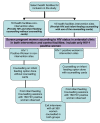Effect of using HIV and infant feeding counselling cards on the quality of counselling provided to HIV positive mothers: a cluster randomized controlled trial
- PMID: 21943308
- PMCID: PMC3189093
- DOI: 10.1186/1746-4358-6-13
Effect of using HIV and infant feeding counselling cards on the quality of counselling provided to HIV positive mothers: a cluster randomized controlled trial
Abstract
Background: Counselling human immunodeficiency virus (HIV) positive mothers on safer infant and young child feeding (IYCF) options is an important component of programmes to prevent mother to child transmission of HIV, but the quality of counselling is often inadequate. The aim of this study was to determine the effect the World Health Organization HIV and infant feeding cards on the quality of counselling provided to HIV positive mothers by health workers about safer infant feeding options.
Method: This was a un-blinded cluster-randomized controlled field trial in which 36 primary health facilities in Kafue and Lusaka districts in Zambia were randomized to intervention (IYCF counselling with counselling cards) or non- intervention arm (IYCF counselling without counselling cards). Counselling sessions with 10 HIV positive women attending each facility were observed and exit interviews were conducted by research assistants.
Results: Totals of 180 women in the intervention group and 180 women in the control group were attended to by health care providers and interviewed upon exiting the health facility. The health care providers in the intervention facilities more often discussed the advantages of disclosing their HIV status to a household member (RR = 1.46, 95% CI [1.11, 1.92]); used visual aids in explaining the risk of HIV transmission through breast milk (RR = 4.65, 95% CI [2.28, 9.46]); and discussed the advantages and disadvantages of infant feeding options for HIV positive mothers (all p values < 0.05). The differences also included exploration of the home situation (p < 0.05); involving the partner in the process of choosing a feeding option (RR = 1.38, 95% CI [1.09, 1.75]); and exploring how the mother will manage to feed the baby when she is at work (RR = 2.82, 95% CI [1.70, 4.67]). The clients in the intervention group felt that the provider was more caring and understanding (RR = 1.81, 95% CI [1.19, 2.75]).
Conclusion: The addition of counselling cards to the IYCF counselling session for HIV positive mothers were a valuable aid to counselling and significantly improved the quality of the counselling session.
Figures
References
-
- WHO, UNICEF, UNAIDS. Progress report 2010. Geneva: WHO; 2010. Towards universal access: Scaling up priority HIV/AIDS interventions in the health sector.http://www.who.int/hiv/pub/2010progressreport/report/en/index.html
-
- Coutsoudis A, Pillay K, Kuhn L, Spooner E, Tsai W, Coovadia HM. for the South African Vitamin A Study Group. Method of feeding and transmission of HIV-1 from mothers to children by 15 months of age: prospective cohort study from Durban, South Africa. AIDS. 2001;15:379–387. doi: 10.1097/00002030-200102160-00011. - DOI - PubMed
LinkOut - more resources
Full Text Sources
Medical


